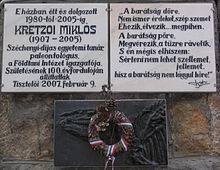Miklós Kretzoi
You can help expand this article with text translated from the corresponding article in French. (March 2018) Click [show] for important translation instructions.
|
Miklós Kretzoi | |
|---|---|
| Born | 9 February 1907 |
| Died | 15 March 2005 (aged 98) |
| Citizenship | Hungary |
| Alma mater | Pázmány Péter University, University of Pécs |
| Known for | Paleoanthropology |
| Awards | Széchenyi Prize |
| Scientific career | |
| Fields | Geology, paleontology |

Miklós Kretzoi (9 February 1907 – 15 March 2005) was a Hungarian geologist, paleontologist and paleoanthropologist[1][2] and Széchenyi Prize winner.[3]
Kretzoi studied Arts and natural sciences at the then Pázmány Péter University, Budapest from 1925 to 1929.[1] While still a student, he worked as a volunteer at the Geological Institute of Hungary.[1]
In 1930 he graduated from the University of Pécs with a PhD in Palaeontology, Geology and Geography.[3] In 1933 he commenced work with the "Hungarian-American Oil Inc" as a geologist and geophysicist. He remained at Hungarian-American Oil until the outbreak of the Second World War.[1] Kretzoi moved to the National Museum of Hungary where he was curator of the Mineralogy and Paleontology departments until he began work at the Geological Institute of Hungary in 1950.[1] Kretzoi was the director of the Geological Institute of Hungary from 1956 to 1958.[4] From the mid-1960s he led the "digs" at Rudabánya where a number of Anthropoid fossil remains were discovered.[1][2]
References
- ^ a b c d e f Begun, David (2005). "Miklo's Kretzoi, 1907–2005" (PDF). University of Toronto. Archived from the original (PDF) on 6 July 2011. Retrieved 15 March 2010.
- ^ a b "Elhunyt Kretzoi Miklós geológus" (in Hungarian). 17 March 2005. Retrieved 15 March 2010.
- ^ a b "Rudabánya and the Early Phase of Hominisation". Retrieved 16 March 2010. Exhibition in the Hungarian National Museum, 9 February - 24 May 2004
- ^ "The short history of the Institute". Archived from the original on 14 March 2010. Retrieved 17 March 2010.
